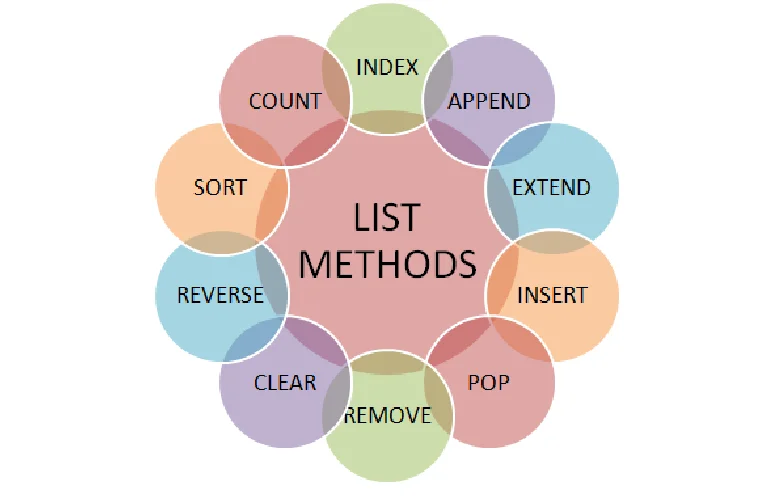A Python list is one of the six built-in sequence types of Python provides for storing data. Together with the linear sequence, the Python list operates as a dynamic array and offers several built-in functions that let you execute different operations on the stored data.
In this article, you’ll learn ‘what a list is in Python,’ how to create a Python list, an example, and much more. From Python list elements to their functions, this article covers it all. So, read till the end.
What are Python Lists
Python lists are the fundamental and undoubtedly the most widely used container. Here is a listicle that can better explain what a list is in Python.
- An ordered, changeable, and diverse group of objects is called a list in Python.
- Order means that the objects are gathered in a specific order.
- The list is mutable if it may be altered or amended.
- Heterogeneous suggests that any form of item, or data type, can be mixed and matched within a List, including an integer, a text, or even another list.
- A comma restricts each element in lists, which are enclosed in a set of square brackets.
- A list is an alterable object indicating that we can loop through a list’s components.
- Lists are similar to the arbitrarily scaled arrays utilized by various coding languages such as Java or C++.

POSTGRADUATE PROGRAM IN
Multi Cloud Architecture & DevOps
Master cloud architecture, DevOps practices, and automation to build scalable, resilient systems.
Create a Python List
Now that we have understood What is a Python List, lets look at how to create Python List. A list is made by inserting the elements/items between square brackets ([ ]) while separating them with commas (,). Let’s look at several various approaches to generating lists in Python.
Moreover, a list with numerous additional lists as its contents can be created is called a nested list. The numerous lists are divided by commas (,) to form the nested list, which is enclosed in square brackets ([ ]).
Access Python List Elements
Every item in a Python list comes with a unique number assigned to it in Python. The figure is often referred to as a list index. When retrieving elements of an array, one can use index numbers (0, 1, 2, …).
Slicing of a Python List

The slicing operator: Python allows you to access a subset of the list’s items rather than just one.
In this case, your list[2:5] returns a list containing entries ranging in the index from 2 to 4.
A list of elements from index 1 to the end is returned by your list[5:]. All list elements are returned by your list[:]. It should be noted that the start index is inclusive. However, the end index is exclusive whenever you slice lists.

82.9%
of professionals don't believe their degree can help them get ahead at work.
Add Elements to a Python List
Python list offers various unique approaches to adding items to a list:
Using Append():
You can add an item to the Python list using the append() method.
For instance,numbers = [17, 36, 71, 27]
print("Before Append:", numbers)
numbers.append(56)
print("After Append:", numbers)
Output Result:
Before Append: [17, 36, 71, 27]
After Append: [17, 36, 71, 27, 56]
The above example of Python list functions demonstrates a list named numbers. Here, numbers.append(56). The append() command adds 56 at the array’s end.
Using Extend():
To add all items of a single list to another, you can use the extend() method. For instance,
prime_numbers = [7, 11, 13]
print("List1:", prime_numbers)
even_numbers = [6,8,10]
print("List2:", even_numbers)
# join two lists
prime_numbers.extend(even_numbers)
print("List after append:", prime_numbers)
OUTPUT RESULT:
List1: [7, 11, 13]
List2: [6, 8, 10]
List after append: [7, 11, 13, 6, 8, 10]Here, you have two lists titled even_numbers and prime_numbers and even_numbers. Keep a note that,
prime_numbers.extend(even_numbers)
Remove an Item from a List
- Using Del()In Python, you can utilize the del statement to eliminate or remove a single or more items from a Python list. For instances,In Python, you can leverage the del statement to remove or eliminate one or more items from a list. For
instance, languages = [‘Swift’, ‘Python’, ‘C’, C++’, ‘Rust’, Java’, ‘R’]
# deleting the second item
del languages[1]
print(languages) # [‘Python’, ‘C’, C++’, ‘Rust’, Java’, ‘R’]
# deleting the very last item
del languages[-1]
print(languages) # [‘Python’, ‘C’, C++’, ‘Rust’, Java’]
# deleting the first two items
del languages[0 : 2] # [C++’, ‘Rust’, Java’]
print(languages)For instance, languages = [‘Swift’, ‘Python’, ‘C’, ‘C++’, ‘Rust’, ‘Java’, ‘R’]
# Removing ‘Swift’ from the Python list
languages.remove(‘Swift’)
print(languages) # [‘Python’, ‘C’, ‘C++’, ‘Rust’, ‘Java’, ‘R’]Here, languages.remove(‘Swift’) removes ‘Swift’ from the languages list.
Characteristics of Lists
After understanding what is a Python List, lets learn more about the major characteristics of List.
The wide range of Python list characteristics includes:
- Lists that are ordered continue to display the data in that order.
- List elements that can be changed are mutable. This implies that we can change the items on the list.
- Heterogeneous: Lists may contain items of different data kinds.
- Dynamic: The list can automatically grow or shrink to fit the items as necessary.
- Duplicate Elements: We can store duplicate data in lists.
List Methods in Python
Python comes with several valuable list methodologies that simplify working with Python lists. Here is a table representing the various Python list methods.
| Method | Definition |
|---|---|
| clear() | Removing or getting rid of all items from the Python list |
| index() | Returning the index of items that matched first |
| pop() | Returns and removes (eliminates) items present at the specified index |
| insert() | Targeting a specific index to insert an item there |
| extend() | Adding items of lists along with other iterables to the list end |
| append() | Adding an item or element on the list end |
| remove() | Removing or getting rid of items present at the specified index |
| copy() | Returning the shallow/duplicate copy of the Python list |
| reverse() | Reverses the item of the Python list |
| sort() | Sorting the Python list in either descending or ascending order |
| count() | Returning the count of the outlined item in the Python list |
Python List Operations
Now that we know what is a Python List, lets look into the operations in a Python List.
Repetition
If you want to repeat the Python list elements several times, you can use the ‘*’ operator.
my_List = [1, 2, 3, 4]
print(my_List*3)
OUTPUT RESULT: [1, 2, 3, 4, 1, 2, 3, 4, 1, 2, 3, 4]Concatenation
With the ‘+’ operator, a Python list can be concatenated with some other list or itself.
List1 = [11, 12, 13, 14]
List2 = [15, 16, 17, 18]
concat_List = List1 + List2
print(concat_List)
OUTPUT RESULT: [11, 12, 13, 14, 15, 16, 17, 18]Length
To get or determine the length of the Python list, use the len() method.
my_List = [6, 7, 8, 9, 10]
print (len(my_List))
OUTPUT RESULT: 10Iteration
A for loop allows you to traverse repeatedly through every item on the list.
my_List = [6, 7, 8, 9, 10]
for n in my_List:
print(n)
OUTPUT:
6
7
8
9
10Membership
You can determine whether a particular element is a component or a member of a Python list.
my_List = [5, 6, 7, 8, 9, 10]
print(7 in my_List)
print(2 in my_List)
print(2 not in my_List)
OUTPUT RESULT:
True
False
TrueExamples of Python List
Here, you’ll be using [ ] to create a Python list:
Var = [“Python”, “Is”, “The”, “Best”]
print(Var)
OUTPUT RESULT: Python Is The BestThe most basic containers used in the Python programming language are lists. The most effective tool in Python is the Python list because they don’t necessarily have to be homogeneous.

Data types such as Strings, Integers, and Objects can all be found in one list. Since lists are mutable, changes can be made to them even after they have been created.
What is a list in Python?
How to make a list in Python?
What is list and tuple in Python?
What is a Python list called?
What is a list vs a tuple?
Updated on September 3, 2024
